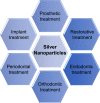The Antibacterial Mechanism of Silver Nanoparticles and Its Application in Dentistry
- PMID: 32368040
- PMCID: PMC7174845
- DOI: 10.2147/IJN.S246764
The Antibacterial Mechanism of Silver Nanoparticles and Its Application in Dentistry
Abstract
Nanotechnology has recently emerged as a rapidly growing field with numerous biomedical science applications. At the same time, silver has been adopted as an antimicrobial material and disinfectant that is relatively free of adverse effects. Silver nanoparticles possess a broad spectrum of antibacterial, antifungal and antiviral properties. Silver nanoparticles have the ability to penetrate bacterial cell walls, changing the structure of cell membranes and even resulting in cell death. Their efficacy is due not only to their nanoscale size but also to their large ratio of surface area to volume. They can increase the permeability of cell membranes, produce reactive oxygen species, and interrupt replication of deoxyribonucleic acid by releasing silver ions. Researchers have studied silver nanoparticles as antimicrobial agents in dentistry. For instance, silver nanoparticles can be incorporated into acrylic resins for fabrication of removable dentures in prosthetic treatment, composite resin in restorative treatment, irrigating solution and obturation material in endodontic treatment, adhesive materials in orthodontic treatment, membrane for guided tissue regeneration in periodontal treatment, and titanium coating in dental implant treatment. Although not all authorities have acknowledged the safety of silver nanoparticles, no systemic toxicity of ingested silver nanoparticles has been reported. A broad concern is their potential hazard if they are released into the environment. However, the interaction of nanoparticles with toxic materials and organic compounds can either increase or reduce their toxicity. This paper provides an overview of the antibacterial use of silver nanoparticles in dentistry, highlighting their antibacterial mechanism, potential applications and safety in clinical treatment.
Keywords: antibacterial; dentistry; nanoparticles; nanotechnology; silver.
© 2020 Yin et al.
Conflict of interest statement
The authors declare that they have no conflicts of interest in this work.
Figures


References
-
- Samuel MS, Jose S, Selvarajan E, Mathimani T, Pugazhendhi A. Biosynthesized silver nanoparticles using Bacillus amyloliquefaciens application for cytotoxicity effect on A549 cell line and photocatalytic degradation of p-nitrophenol. J Photochem Photobiol. 2020;202:111642. - PubMed
Publication types
MeSH terms
Substances
LinkOut - more resources
Full Text Sources
Other Literature Sources
Medical

